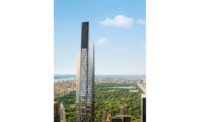It’s the same 790,000-sq-ft office tower on Sixth Avenue between 44th and 45th streets in Manhattan built in 1984. But a multistage $130-million upgrade, and ongoing fit-outs, are converting 1155 Avenue of the Americas into a stylish property—with an upsized lobby, recast floor-to-ceiling glass in its chamfered corners, updated infrastructure and an impressive space redesign that now places its highest-dollar leases in previously unused areas.
What had been a hulking 41-floor black obelisk with a polished granite exterior and tinted punched windows now radiates a modern and light look—thanks in large part to cosmetic yet strategic changes, operational system upgrades and a reallocation of usable floor area ratio. The moves underscore a practical approach by the Durst Organization—the original developer, current building owner and renovation supervisor—to invest in upgrades to meet tenant expectations. “We went from 53% occupancy in 2019 to 93% leased today,” says Jonathan “Jody” Durst, president of the family-owned developer and real estate owner, which signed on two major tenants in recent months.
The project got its start in 2016 when the building’s anchor tenant—a law firm with space there since it opened—made plans to move, Durst says. “We saw an opportunity to invest in the building, to reposition and modernize the tower,” he says.
Achieving a fresh look for a building without changing its core exterior and total floor area ratio was a challenge, says Graham Clegg, partner at Studios Architecture, the project’s design architect.
“It was a complicated puzzle, how to renovate the entire building as it was, to have a true transformation even though it wasn’t much more than 30 years old,” he says.

Project work included demolishing the existing building facade that encased the cooling towers and other mechanical services and adding supplemental steel to the previous top floor. Also part of the scope was constructing the new shell, including the steel structure, metal panels, glass front, new roof and rooftop.
Photo by Jeremy Frechette
High Ceiling
Few elements capture the change better than work to replace the original lobby entrances that were cramped, single-story, dark and “a bit foreboding,” Clegg says. The team removed what had been the primary entrance on Sixth Avenue and instead placed the main lobby on the 44th Street side behind a sleek glass curtain wall, he says. That configuration also simplified lobby circulation while allowing Durst Organization to lease the entire Sixth Avenue frontage to retail, he adds. The team also integrated an inviting outdoor plaza with seating and planters into the lobby design.
“It was a complicated puzzle.”
—Graham Clegg, Partner, Studios Architecture
But the signature feature was turning the 4,800-sq-ft lobby into a bright, two-story, white-walled atrium by carving out portions of the second and third floors, which were primarily leased by Verizon as switch rooms. Durst worked with tenants to reconfigure their spaces to free up those portions of the building for the work, Clegg says. “Unlocking that was a big win,” he adds.
Repurposing parts of the second and third floors also delivered a giant additional benefit: freeing up enough zoned floor area ratio to allow Durst to transform the roof—until then housing only mechanical equipment—into the building’s most valuable office space, with an 8,000-sq-ft glass-enclosed section and 4,000-sq-ft landscaped wrap-around terrace that are part of a three-story penthouse suite. That space is in its final build-out phase to house Global Relay USA, a cloud-based electronic messaging platform for financial firms that leased the tower’s top five floors in 2022.
“We moved that [area] on the lowest floors to the highest rent in the building all the way at the top,” Clegg says. Durst Organization would not disclose actual current tenant rent figures or comparative asking rents pre-2020, but said asking rents for recent tenants ranged from $85/sq ft on low floors to $115/sq ft on the five highest floors. In a 2022 report, however, the New York Post said asking rent for Global Relay USA’s 42nd floor was $150/sq ft.
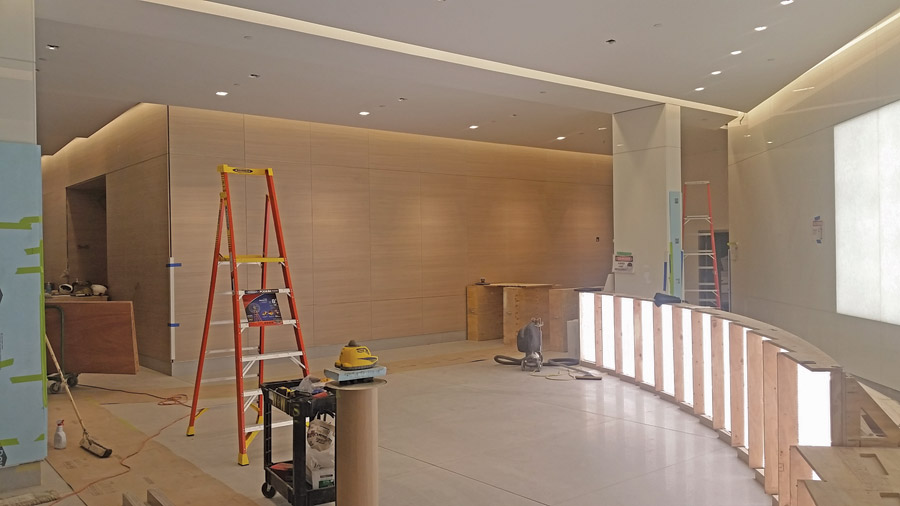
Interior upgrades have helped attract new tenants.
Photo courtesy Studios Architecture
A Staged Journey
The renovation of 1155 Avenue of the Americas did not take a linear path—largely because major tasks progressed around existing tenants or as spaces became vacant. The team featured various consultants and contractors overlapping on a range of tasks that required significant coordination. The team included Studios Architecture leading design of the lobby, rooftop and reworked chamfered corners; Gensler as architect on infrastructure upgrades; Severud Associates as structural engineer; WSP Group as MEP consultant on most of the project; Skanska USA Building as contractor on the roof pavilion, terraces and infrastructure upgrades; and Plaza Construction as contractor on the lobby and chamfered corners.
The bulk of construction occurred between 2017 and 2019, but later work has included reframing of rooftop space and major fit-outs for key tenants. Projects continuing into this year include final work on Global Relay’s space by JRM Construction Management and Durst Organization, as well as fit-outs of 10,000 sq ft for consultant IMA New York and 66,000 sq ft for research firm Everest Group. Durst Organization also moved in earlier this year to a newly finished 100,000-sq-ft space.
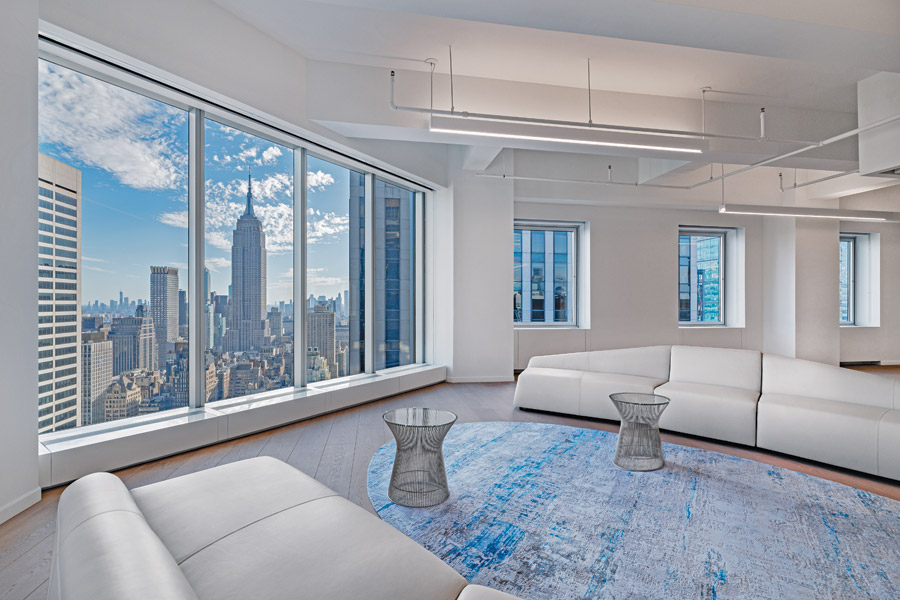
The building’s most recent work includes major fit-outs for such key tenants as financial tech firm Global Relay USA, consultant IMA New York and research firm Everest Group.
Photo by Giles Ashford
Rooftops and Setbacks
Adding key project features—the upgraded lobby and rooftop—presented unique challenges in design, construction sequencing and simple coordination around critical building infrastructure.
“The lobby was a huge undertaking structurally,” Clegg says. Its atrium “required cutting back from the front of the building and disconnecting the floors from columns,” he adds, as well as “reinforcing the existing columns so that they could be unbraced for three stories.”
The new outdoor plaza now sits on top of a switchgear vault, requiring additional maneuvering, Clegg says. Similarly, the rooftop space—which Durst initially built on spec for $20 million—called for significant structural reinforcement to support a new office floor around the existing cooling towers and other mechanical systems, which remain in place but out of view.
“The scope included demolishing the existing building facade that encased the cooling towers and other mechanical services.”
—Christian Schuler, Project Executive, Skanska USA Building
The rooftop was part of Skanska’s 36,000 sq ft of work on the renovation, says Christian Schuler, project executive.
“The scope included demolishing the existing building facade that encased the cooling towers and other mechanical services, adding supplemental steel to the [previous] top floor and constructing the new shell, including the steel structure, metal panels, glass front, new roof and rooftop units,” he says. “In addition, an elevator was added for access.”
The rooftop office features 13-ft windows that use View glass, which automatically provides tint based on the sun’s intensity and position, reducing glare and energy consumption.
The project also repurposed two other previously unused setbacks at the seventh and 14 floors into high-end outdoor terraces. The seventh floor has a 6,000-sq-ft terrace that turned the space into a prime area with views of Bryant Park and Central Park and was part of the lease that Everest signed earlier this year.
“The rooftop terrace and setback areas mean that 160,000 sq ft of the building’s leased space is connected to outdoor terraces,” Durst says. That work also required additional structural work to support the load bearing capacity of the terraces, he adds.
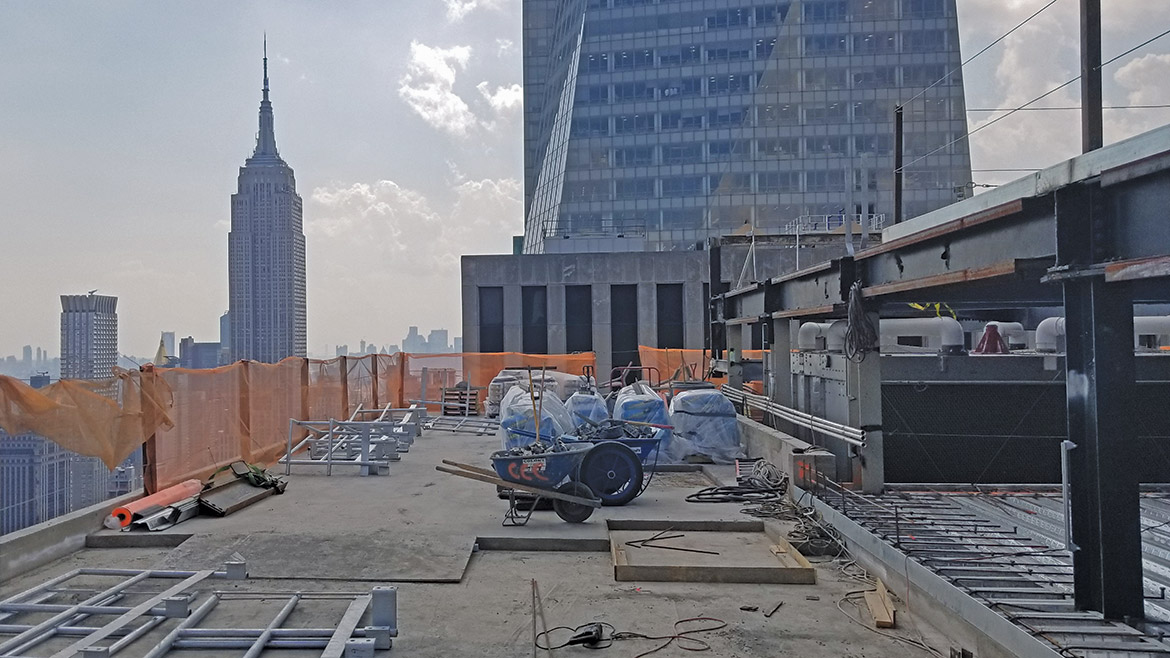
The $130-million upgrade of the 1155 Avenue of the Americas office tower includes converting unused roof spaces into landscaped terraces now commanding the building’s highest rents.
Photo courtesy Studios Architecture
Hot Corners
The original building’s chamfered corners were a noted design feature that developed from an effort by Jody Durst’s father and uncles to land the law firm anchor tenant that wanted to rent 11 floors. But the firm had 88 partners—each of whom expected corner offices.
The chamfered design—which instead of a typical 90° angle where two building sides meet, uses a 45° section to “flatten” the joint—allowed for two “corner offices” at each corner, or eight per floor, which was enough to attract the tenant.
But those chamfered corners still had the old window units and stone spandrels, making them a prime target for renovation. The project called for replacing those corners with floor-to-ceiling low-emissivity glass that provided each floor with a greatly improved exterior view. “It was a rethink of those corners,” Clegg says. “They were competing against new buildings with floor-to-ceiling glass in Midtown.”
The effort required reconfiguring mechanical systems and ensuring new windows are properly attached to the slab and curtain wall, he adds. But on many floors, including those with such existing tenants as Verizon and Cornell University, that also required extensive preparation, Durst says. “We carved out an area of the floor and made it weatherproof so the work could take place [while] the tenants on that floor could continue using most of the floor,” he notes.
The project also replaced the rest of the tinted windows on each floor with clear, high-performance energy efficient glass—one of many features that helped the building gain LEED Gold certification, Durst adds.
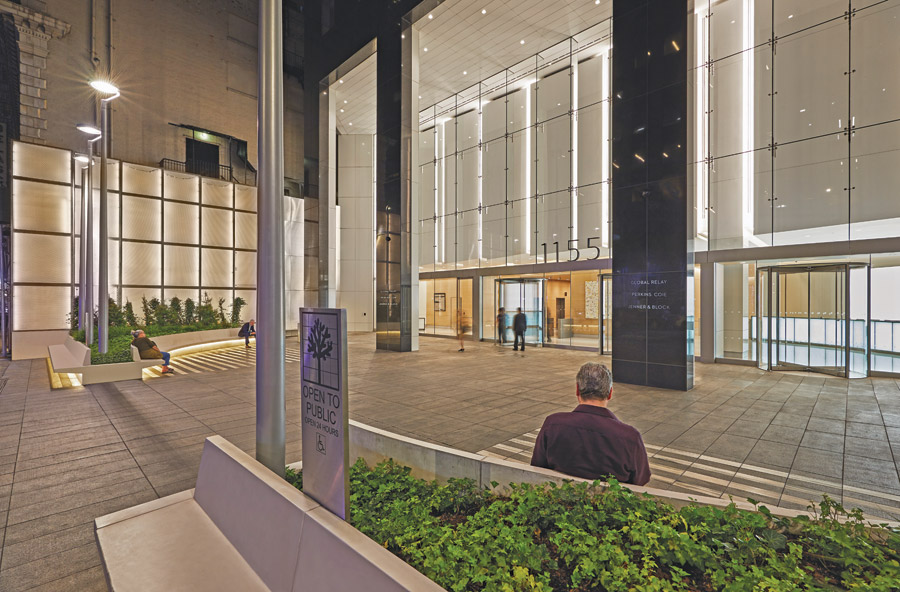
The main lobby is now on the building’s 44th Street side behind a sleek glass curtain wall, replacing the original cramped entrances on Sixth Avenue.
Photo by Jeremy Frechette
Core and Shell
Another project accomplishment was behind the scenes—upgrades to key building systems, according to Durst. These included new high-efficiency floor-to-floor air handling units, fire alarm and life safety generator systems and a building-wide cellular distributed antenna platform. Other big efforts included rebuilt cooling towers, a new elevator system and chiller plant, renovated bathrooms and updated plumbing infrastructure.
Much of that effort—which involved extensive demolition and construction—required strategic planning to accommodate tenants, such as conducting most work after normal business hours, Schuler says. “To avoid disrupting tenant operations in other areas of the building, Skanska used our first shift, from 7:00 a.m. to 3:00 p.m., to coordinate our work,” he says. “We then committed the next 16 hours to demolition work.”
By maintaining this routine, the Skanska team completed the demolition phase in the client’s expected time frame and stayed on track for the overall project deadline, according to Schuler. Skanska’s team performed that work on 30 floors, he says.
“We went from 53% occupancy in 2019 to 93% leased today.”
—Jody Durst, President, Durst Organization
“Our trades worked from the top down, two floors at a time, with one trade following the other as soon as [its] package was complete,” Schuler says. That involved regular contact with tenants, he notes, adding that “it was crucial that our team communicated our work regularly to avoid disturbing” tenant operations.
Similarly, working alongside and coordinating with Plaza Construction and other contractors was critical to maintain project safety and schedule, Schuler adds. “At the height of the project, the Skanska team alone had nearly 150 personnel on site,” he says.
“In addition to our workforce, another construction manager with a team of 30 was simultaneously working on the building’s facade,” Schuler says. “Our team made sure to clearly communicate work plans, loading dock delivery schedules and elevator usage at every step of the project.”
The last stages of work sparked by the renovation are underway, including build-out of the seventh, eighth and ninth floors for Everest. Only the building’s 37th floor is still fully available, with several others partially so, according to Durst Organization’s website.
The project’s extended path has ended up as an advantage after the COVID-19 pandemic, with evolving market demands that now include tenants putting a priority on outdoor spaces, Durst says.
“We believe the renovation was very well timed—current demand for Class A office space has attracted a new generation of tenants to the building,” he says.



